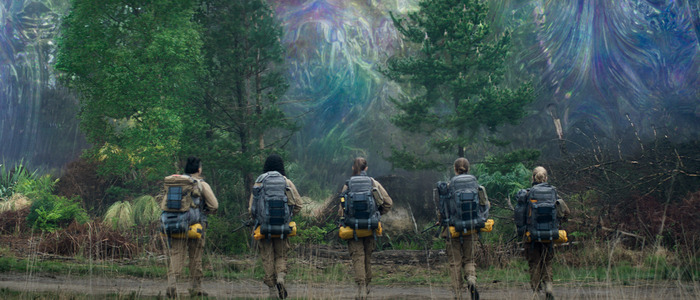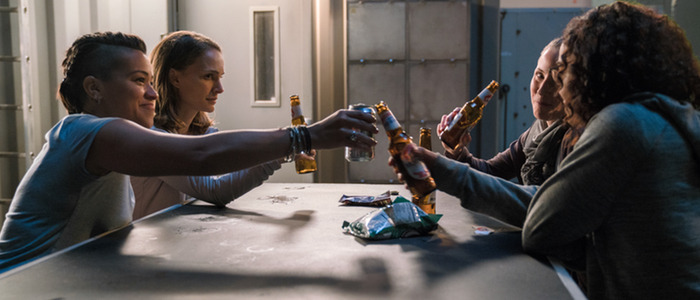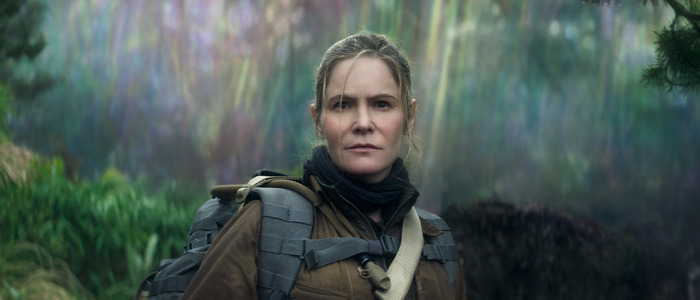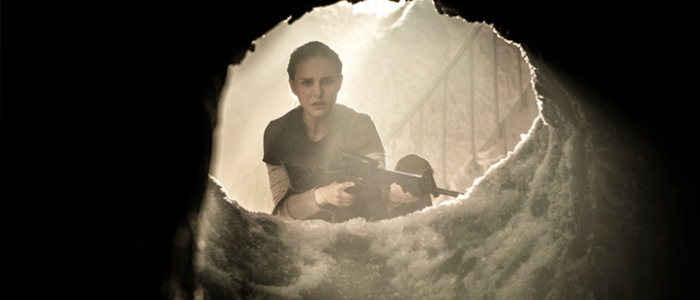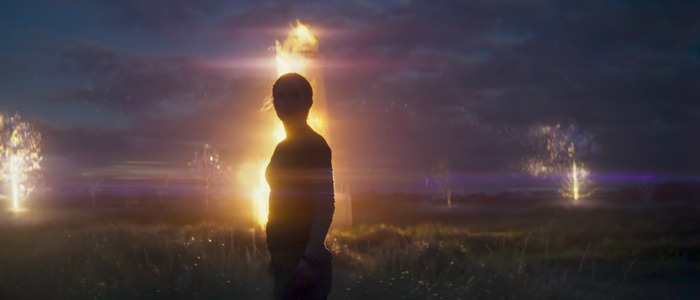'Annihilation': The Major Differences Between The Book And The Film
Alex Garland's weird, wonderful adaptation of Jeff VanderMeer's Annihilation hits theaters this week. Anyone who read the novel and watched the trailers could've guessed Garland took liberties with the source material. Below, we examine some of the major Annihilation differences between book and film. There are a lot of them.Major spoilers for both book and film follow.
Let me be blunt: almost everything in Alex Garland's film adaptation of Annihilation is different than the book. I could literally go through nearly every scene in the film and point out how much was changed from VanderMeer's novel.
On the surface, it seems Garland took the basic concept of the book – a team of female scientists venture into a strange area – and formed his own story. Whether or not this is a good thing is up to you to decide. I loved the film – it's unapologetically weird and frequently terrifying. But at the same time, I found myself a bit confused as to why Garland made so many changes. Changes from book to film are part of any movie adaptation, but the changes here are extreme. Extreme to the point where one can't help but wonder why Garland didn't simply craft his own original story instead of attempting to adapt VanderMeer's book.
During a recent Q&A, Garland commented that he read VanderMeer's book once, and never went back to it again while working on his adaptation. He simply adapted it all from memory. If you're curious about some of the major changes from book to screen, I've put together a handy list below. Again, these aren't all of the changes, but rather the most prominent differences. If you have yet to read the book or see the film and are wary of spoilers, turn back now. Otherwise, follow me into Area X below. Or should I say The Shimmer?
Area X and The Shimmer
In the Annihilation book, the strange events of Area X are, for the most part, well-known. The main character, the Biologist, is well aware of them before her husband ventures across the border and vanishes. In the film, however, Natalie Portman's character Lena has no idea about the phenomena. She believes her husband is going on some sort of top secret mission to another country. She only finds out about the border and Area X after he mysteriously returns after vanishing.Speaking of Area X, the film curiously redefines what it is. In VanderMeer's book, Area X is the "infected" area the characters venture into. In Garland's film, Area X is the location just outside of the afflicted area. "The Shimmer" is the term the characters use to describe the mysterious zone they travel into – no such term is used in the book.The film's depiction of Area X/The Shimmer is vastly different than the book. VanderMeer comments early on that the characters are trekking through "pristine wilderness," and for a large portion of the story, they don't come across anything outwardly strange. In sharp contrast, the film presents Area X/The Shimmer as a strange, unearthly area where everything is warped. There are also mutated animals, including a huge alligator and a terrifying bear-like creature, that attack the team very early on. Nothing even slightly resembling this happens in the novel.
The Outside World
Garland's film adaptation has a lengthy section set in the outside world, where we meet Portman's biologist character and the rest of the team before they venture across the border into Area X/The Shimmer. VanderMeer's book forgoes all of this, and opens with the characters already in mid-mission, traveling through Area X. The Biologist character, who narrates the book, will occasionally bring up events that happened in the outside world before the expedition, but they are few and far between.
The Team
In Jeff VanderMeer's novel, we never learn the names of the main characters. They're simply referred to by their particular fields – Anthropologist, Surveyor, Biologist, and Psychologist. There is also a never-seen member of the team, a Linguist, who backs out before they cross into Area X.The film changes this considerably. For one thing, we learn the names of all the characters. For another, almost all their specific roles have been changed. The only two who remain the same are the biologist (Natalie Portman) and the psychologist (Jennifer Jason Leigh). The rest of the team now consists of a paramedic (Gina Rodriguez), a physicist (Tessa Thompson) and a magnetologist (Tuva Novotny).VanderMeer's book keeps most of these characters – save the Biologist and the Psychologist – mysterious, but the film fleshes them out and gives them a bit of backstory. The film also keeps most of them alive much longer than the novel. In the Annihilation book, the Anthropologist character dies almost immediately and the Psychologist vanishes. After tracking the Psychologist down, the Biologist is attacked by the Surveyor, and forced to kill her. Nothing even close to this happens in the movie.
The Mission
Alex Garland's film sets up a specific reason for Portman's biologist Lena to cross into Area X (or The Shimmer, as the film calls it). Portman's husband Kane (Oscar Isaac) mysteriously returns home after having vanished for over a year, and is instantly taken sick. Kane ends up on life support in the medical bay of a military base, and Lena then gets a crash-course in Area X/The Shimmer. Lena decides to join the next mission into The Shimmer with the hopes of trying to find a way to save her husband's life.The book contains the similar scenario of the Biologist's husband returning home mysteriously, but the husband character dies quickly after. He doesn't end up on life support, and the Biologist doesn't venture into Area X with some hope of curing him. The Biologist's reasoning for joining the mission is a lot more complicated – she herself doesn't quite seem to understand it.
Hypnosis
Hypnosis plays a big part in the novel, but never comes up in the film. In VanderMeer's book, it's revealed that crossing over the border into Area X is too traumatic for the human mind, and the team needs to be hypnotized by the Psychologist beforehand. In the film, the characters simply stroll on through.Later in the book, the Biologist discovers the Psychologist has been using hypnosis on the team throughout the whole mission, in a sense forcing them to do things they otherwise wouldn't do. The Biologist becomes impervious to the hypnosis, and is able to resist the Psychologist.The Psychologist imploys hypnotic suggestions through words or phrases. This is where the title comes from – "Annihilation" is the hypnotic phrase meant to force the team to kill themselves should something go terribly wrong.
The Tower
Early in VanderMeer's novel, the team discovers a structure going down into the earth. While the bulk of the group thinks of this as a "tunnel," the Biologist continually refers to it as a "tower," though she can't quite say why. This isn't a naturally occuring anomaly – it's clearly a man-made structure buried into the earth, as the characters find a staircase within.The team ventures down into the tower, where they find strange words written on the wall – "Where lies the strangling fruit that came from the hand of the sinner I shall bring forth the seeds of the dead to share with the worms..." Upon closer examination, it's revealed these words aren't merely written on the wall – they're actually formed from a plant-like material. Spores from the plant-formed words infect the Biologist, and cause her to begin to change.Garland's novel almost cuts the tower entirely. Late in the film, Portman's biologist character arrives at a lighthouse. Inside the building, there is a hole in the wall that burrows into a strange, unearthly cave. One can assume Garland drew on the book's tower for inspiration for this, but it's vastly different here than its novel counterpart.
The Ending and Beyond
Without spoiling the entire ending of Garland's film, let's just say that the Annihilation movie ending leaves very little room for a sequel. VanderMeer's book, however, is the complete opposite. After all, it's the first book in a trilogy. The Annihilation novel concludes in an open-ended manner, with Area X still very much thriving and the Biologist's fate left open. Garland nixes most of this for a more conclusive, but also haunting, finale.In other words, don't hold your breath for a sequel.

